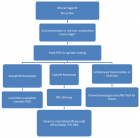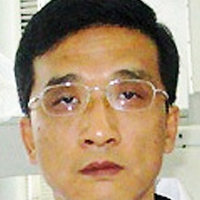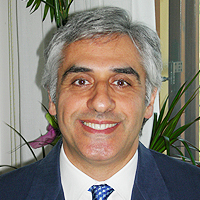Abstract
Research Article
The effects of boric acid and disodium pentaborate dechydrate in metastatic prostate cancer cells
Merve Tütüncü*, Selen Kum Özşengezer, Tuğba Karakayali and Zekiye S Altun
Published: 15 July, 2022 | Volume 6 - Issue 2 | Pages: 012-017
Boron and their derived molecules have prevention or treatment potential against prostate cancer. In this study, we aim to investigate the effects of Boric acid (BA) and Disodium Pentaborate Dechydrate (DPD) in metastatic prostate cancer cells such as DU-145 which is brain metastatic prostate cancer, and PC3 which is bone metastatic prostate cancer.
Metastatic human prostate cancer cell lines, PC-3 and DU-145, were used to show whether inhibition effects of BA and DPD on prostate cancer cells in this study. BA and DPD were applied for 24 hours to the cells. Cell viability determination was performed using WST-1 assay. Apoptotic cell death was evaluated with Annexin-V/PI flow cytometric analysis and caspase-3 expression immunohistochemically. A wound healing assay was also used to measure cancer cell migration after exposure to BA and DPD.
Applying BA and DPD made inhibition of cell proliferation in both BA (1 mM) and DPD (7 mM) at 24 h. The results of Annexin-V/PI showed that DPD induced higher levels of apoptosis than BA in both prostate cancer cells. Caspase-3 expressions were also higher than BA with DPD in both metastatic prostate cancer cells. We evaluated cell migration using a wound healing assay and the result showed that cell migration was inhibited with BA and DPD in both cells.
Both BA and DPD inhibited the cell viability of metastatic prostate cancer cells. Apoptotic cell death with applying DPP had a higher rate than BA treatment. Moreover, BA and DPD inhibited cell migration in both cells when we compared them with control. This study’s results showed that BA and DPD of boron derivates significantly induced cells to apoptosis and the migration was inhibited by the derived form of boron in metastatic prostate cancer cells.
Read Full Article HTML DOI: 10.29328/journal.jro.1001041 Cite this Article Read Full Article PDF
References
- Karantanos T, Corn PG, Thompson TC. Prostate cancer progression after androgen deprivation therapy: mechanisms of castrate resistance and novel therapeutic approaches. Oncogene. 2013 Dec 5;32(49):5501-11. doi: 10.1038/onc.2013.206. Epub 2013 Jun 10. PMID: 23752182; PMCID: PMC3908870.
- Abate-Shen C, Shen MM. Molecular genetics of prostate cancer. Genes Dev. 2000 Oct 1;14(19):2410-34. doi: 10.1101/gad.819500. PMID: 11018010.
- Devirian TA, Volpe SL. The physiological effects of dietary boron. Crit Rev Food Sci Nutr. 2003;43(2):219-31. doi: 10.1080/10408690390826491. PMID: 12705642.
- Woods WG. An introduction to boron: history, sources, uses, and chemistry. Environ Health Perspect. 1994 Nov;102 Suppl 7(Suppl 7):5-11. doi: 10.1289/ehp.94102s75. PMID: 7889881; PMCID: PMC1566642.
- Barranco WT, Kim DH, Stella SL Jr, Eckhert CD. Boric acid inhibits stored Ca2+ release in DU-145 prostate cancer cells. Cell Biol Toxicol. 2009 Aug;25(4):309-20. doi: 10.1007/s10565-008-9085-7. Epub 2008 May 31. PMID: 18516691.
- Nielsen FH. Biochemical and physiologic consequences of boron deprivation in humans. Environ Health Perspect. 1994 Nov;102 Suppl 7(Suppl 7):59-63. doi: 10.1289/ehp.94102s759. PMID: 7889883; PMCID: PMC1566640.
- Gallardo-Williams MT, Chapin RE, King PE, Moser GJ, Goldsworthy TL, Morrison JP, Maronpot RR. Boron supplementation inhibits the growth and local expression of IGF-1 in human prostate adenocarcinoma (LNCaP) tumors in nude mice. Toxicol Pathol. 2004 Jan-Feb;32(1):73-8. doi: 10.1080/01926230490260899. PMID: 14713551.
- Korkmaz M, Avcı CB, Gunduz C, Aygunes D, Erbaykent-Tepedelen B. Disodium pentaborate decahydrate (DPD) induced apoptosis by decreasing hTERT enzyme activity and disrupting F-actin organization of prostate cancer cells. Tumour Biol. 2014 Feb;35(2):1531-8. doi: 10.1007/s13277-013-1212-2. PMID: 24122279.
- Fuchs Y, Steller H. Programmed cell death in animal development and disease. Cell. 2011 Nov 11;147(4):742-58. doi: 10.1016/j.cell.2011.10.033. Erratum in: Cell. 2011 Dec 23;147(7):1640. PMID: 22078876; PMCID: PMC4511103.
- Barranco WT, Eckhert CD. Cellular changes in boric acid-treated DU-145 prostate cancer cells. Br J Cancer. 2006 Mar 27;94(6):884-90. doi: 10.1038/sj.bjc.6603009. PMID: 16495920; PMCID: PMC3216419.
- Altun ZS, Tanrıverdi Akhisaroğlu S, Batu J, Ates H, Giray H, Kocturk S. Discrimination Effectiveness of CK18 on Cell Death Modes in Colon Cancer Cells. Turk J Biochem. 2010; 35(1): 20–28.
- Javois LC. Immunocytochemistry Methods and Protocols. 2nd edition, Human Press. 64- 70.
- Barranco WT, Hudak PF, Eckhert CD. Evaluation of ecological and in vitro effects of boron on prostate cancer risk (United States). Cancer Causes Control. 2007 Feb;18(1):71-7. doi: 10.1007/s10552-006-0077-8. Erratum in: Cancer Causes Control. 2007 Jun;18(5):583-4. PMID: 17186423.
- Barranco WT, Eckhert CD. Boric acid inhibits human prostate cancer cell proliferation. Cancer Lett. 2004 Dec 8;216(1):21-9. doi: 10.1016/j.canlet.2004.06.001. PMID: 15500945.
- Yamada KE, Eckhert CD. Boric Acid Activation of eIF2α and Nrf2 Is PERK Dependent: a Mechanism that Explains How Boron Prevents DNA Damage and Enhances Antioxidant Status. Biol Trace Elem Res. 2019 Mar;188(1):2-10. doi: 10.1007/s12011-018-1498-4. Epub 2018 Sep 8. PMID: 30196486.
- Henderson KA, Kobylewski SE, Yamada KE, Eckhert CD. Boric acid induces cytoplasmic stress granule formation, eIF2α phosphorylation, and ATF4 in prostate DU-145 cells. Biometals. 2015 Feb;28(1):133-41. doi: 10.1007/s10534-014-9809-5. Epub 2014 Nov 26. PMID: 25425213; PMCID: PMC4300416.
- McAuley EM, Bradke TA, Plopper GE. Phenylboronic acid is a more potent inhibitor than boric acid of key signaling networks involved in cancer cell migration. Cell Adh Migr. 2011 Sep-Oct;5(5):382-6. doi: 10.4161/cam.5.5.18162. PMID: 21975546; PMCID: PMC3218604.
Figures:

Figure 1

Figure 2

Figure 3

Figure 4
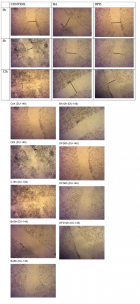
Figure 5
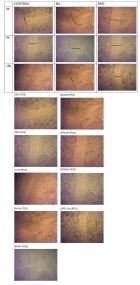
Figure 6
Similar Articles
-
A Short Synthesis Concerning Biological Effects and Equivalent Doses in RadiotherapyCyril Voyant*,Daniel Julian. A Short Synthesis Concerning Biological Effects and Equivalent Doses in Radiotherapy. . 2017 doi: 10.29328/journal.jsmt.1001036; 1: 039-045
-
Inter-Observer Variability of a Commercial Patient Positioning and Verification System in Proton TherapyYuanshui Zheng*,Xiaoning Ding. Inter-Observer Variability of a Commercial Patient Positioning and Verification System in Proton Therapy. . 2017 doi: 10.29328/journal.jro.1001004; 1: 031-038
-
Using Mathematical Procedure to Compute the Attenuation Coefficient in Spectrometry FieldMohamed. S. Badawi*,Mohamed Elsaf,Mona. M. Gouda,Abouzeid A Thabet,Ahmed M El-Khatib,Mahmuod I Abbas,Kholud. S. Almugren. Using Mathematical Procedure to Compute the Attenuation Coefficient in Spectrometry Field. . 2017 doi: 10.29328/journal.jro.1001003; 1: 022-030
-
Empirical formulae for calculating γ-ray detectors effective solid angle ratioMohamed. S. Badawi*,Ahmed M El Khatib,Mohamed A Elzaher,Mona M Gouda,Abouzeid A Thabet,Mahmoud I Abbas,Kholud S Almugren. Empirical formulae for calculating γ-ray detectors effective solid angle ratio. . 2017 doi: 10.29328/journal.jro.1001002; 1: 012-021
-
New Approach for Analysing the Discrepancy of Pretherapeutic Tc-99m and Intra-therapeutic I-131 uptake in Scintigraphies of Thyroid Autonomies using a Parametric 3D Analysis ProgramMaaz Zuhayra,Marlies Marx,Ulrich Karwacik,Yi Zhao,Ulf Lützen*. New Approach for Analysing the Discrepancy of Pretherapeutic Tc-99m and Intra-therapeutic I-131 uptake in Scintigraphies of Thyroid Autonomies using a Parametric 3D Analysis Program. . 2017 doi: 10.29328/journal.jro.1001001; 1: 001-011
-
Photon Absorption characteristics of some selected Enzyme Inhibitors used in Cancer Research in the Energy range 1 keV-100 GeVMustafa Recep Kaçal,Hüseyin Ali Karataş,Ferdi Akman*. Photon Absorption characteristics of some selected Enzyme Inhibitors used in Cancer Research in the Energy range 1 keV-100 GeV. . 2017 doi: 10.29328/journal.jro.1001009; 1: 060-068
-
Radiological evaluation of a Chondromyxoid FibromaAustin Fletcher*,Megan Mastragostino. Radiological evaluation of a Chondromyxoid Fibroma. . 2017 doi: 10.29328/journal.jro.1001008; 1: 054-059
-
Time to Terminate LNT: Radiation Regulators Should Adopt LTJeffry A Siegel*,Bill Sacks,James S Welsh3. Time to Terminate LNT: Radiation Regulators Should Adopt LT. . 2017 doi: 10.29328/journal.jro.1001007; 1: 049-053
-
Metallic Ureteric Stents a cost-effective alternative in the management of Obstructed Distal UretersErich K Lang*. Metallic Ureteric Stents a cost-effective alternative in the management of Obstructed Distal Ureters. . 2017 doi: 10.29328/journal.jro.1001006; 1: 046-048
-
Synthesis, Radioiodination and Biological distribution of 5-(5-(tributylstannyl) benzofuran-2-yl) pyridin-2-amine as an amyloid imaging agentAtteyat A Labib*,Mohsen B Challan. Synthesis, Radioiodination and Biological distribution of 5-(5-(tributylstannyl) benzofuran-2-yl) pyridin-2-amine as an amyloid imaging agent. . 2017 doi: 10.29328/journal.jro.1001013; 1: 087-093
Recently Viewed
-
Methodology for Studying Combustion of Solid Rocket Propellants using Artificial Neural NetworksVictor Abrukov*, Weiqiang Pang, Darya Anufrieva. Methodology for Studying Combustion of Solid Rocket Propellants using Artificial Neural Networks. Ann Adv Chem. 2024: doi: 10.29328/journal.aac.1001048; 8: 001-007
-
A Study on Potential Feed Sources to Boost Guppy Fish, Poecilia reticulata ProductivityCV Vedhavarshini, Swetha A, Harini Sri M, Kaviya K, Ann Suji H, Deivesigamani B*. A Study on Potential Feed Sources to Boost Guppy Fish, Poecilia reticulata Productivity. Ann Adv Chem. 2024: doi: 10.29328/journal.aac.1001049; 8: 008-011
-
Using Isomets as a Foundation, a Connection Factor between Nucleation and Atomic PhysicsEsraa Fareed Saeed*. Using Isomets as a Foundation, a Connection Factor between Nucleation and Atomic Physics. Ann Adv Chem. 2024: doi: 10.29328/journal.aac.1001050; 8: 012-018
-
Techno-econophysics’ Fractal Involving of Exergy RemarksWidastra Hidajatullah Maksoed*. Techno-econophysics’ Fractal Involving of Exergy Remarks. Ann Adv Chem. 2024: doi: 10.29328/journal.aac.1001051; 8: 017-020
-
Comparative Studies of Diclofenac Sodium (NSAID) Adsorption on Wheat (Triticum aestivum) Bran and Groundnut (Arachis hypogaea) Shell Powder using Vertical and Sequential Bed ColumnNeha Dhiman*. Comparative Studies of Diclofenac Sodium (NSAID) Adsorption on Wheat (Triticum aestivum) Bran and Groundnut (Arachis hypogaea) Shell Powder using Vertical and Sequential Bed Column. Ann Adv Chem. 2024: doi: 10.29328/journal.aac.1001052; 8: 021-029
Most Viewed
-
Evaluation of Biostimulants Based on Recovered Protein Hydrolysates from Animal By-products as Plant Growth EnhancersH Pérez-Aguilar*, M Lacruz-Asaro, F Arán-Ais. Evaluation of Biostimulants Based on Recovered Protein Hydrolysates from Animal By-products as Plant Growth Enhancers. J Plant Sci Phytopathol. 2023 doi: 10.29328/journal.jpsp.1001104; 7: 042-047
-
Sinonasal Myxoma Extending into the Orbit in a 4-Year Old: A Case PresentationJulian A Purrinos*, Ramzi Younis. Sinonasal Myxoma Extending into the Orbit in a 4-Year Old: A Case Presentation. Arch Case Rep. 2024 doi: 10.29328/journal.acr.1001099; 8: 075-077
-
Feasibility study of magnetic sensing for detecting single-neuron action potentialsDenis Tonini,Kai Wu,Renata Saha,Jian-Ping Wang*. Feasibility study of magnetic sensing for detecting single-neuron action potentials. Ann Biomed Sci Eng. 2022 doi: 10.29328/journal.abse.1001018; 6: 019-029
-
Pediatric Dysgerminoma: Unveiling a Rare Ovarian TumorFaten Limaiem*, Khalil Saffar, Ahmed Halouani. Pediatric Dysgerminoma: Unveiling a Rare Ovarian Tumor. Arch Case Rep. 2024 doi: 10.29328/journal.acr.1001087; 8: 010-013
-
Physical activity can change the physiological and psychological circumstances during COVID-19 pandemic: A narrative reviewKhashayar Maroufi*. Physical activity can change the physiological and psychological circumstances during COVID-19 pandemic: A narrative review. J Sports Med Ther. 2021 doi: 10.29328/journal.jsmt.1001051; 6: 001-007

HSPI: We're glad you're here. Please click "create a new Query" if you are a new visitor to our website and need further information from us.
If you are already a member of our network and need to keep track of any developments regarding a question you have already submitted, click "take me to my Query."









